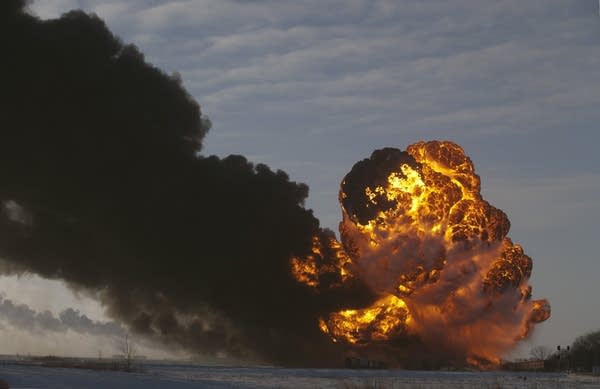NTSB: Safety improved since Casselton train accident, but more work needed

Go Deeper.
Create an account or log in to save stories.
Like this?
Thanks for liking this story! We have added it to a list of your favorite stories.
Updated: 4:12 p.m. | Posted: 6:19 a.m.
The National Transportation Safety Board on Tuesday approved a final report on the fiery oil train accident near Casselton North Dakota three years ago, saying the accident has led to safety improvements, but more work is needed on oil train safety.
The report concluded a manufacturing defect inside the axle of a train car started the accident, which ultimately led to the evacuation of 1,400 people and a national debate about oil train safety.
Turn Up Your Support
MPR News helps you turn down the noise and build shared understanding. Turn up your support for this public resource and keep trusted journalism accessible to all.
NTSB investigators said if the axle had been more thoroughly tested when wheels and bearings were replaced in 2010, the flaw would have been found. That testing is now required.
The broken axle caused a car loaded with soybeans to derail and fall across an adjacent track, right in the path of an oncoming oil train.
Video from inside the BNSF railroad locomotive showed the engineer had little time to react. Eighteen tank cars leaked, spilling 470,000 gallons of oil that erupted in massive explosions. Fire broke out quickly, threatening the two crew members in the locomotive.
The crew couldn't get out of the damaged front locomotive door, so they had to leave through the back, in the direction of the burning oil tank cars.
The train had a single buffer car containing non-hazardous material — in this case a hopper car filled with sand — between the engines and the tank cars.
Federal rules call for five buffer cars, but railroads and regulators have interpreted that to apply only when a train would otherwise be transporting cars with non-hazardous materials. Under this reading, they're not required to add more than one non-hazardous buffer car to a train that wouldn't be pulling non-hazardous cars.
NTSB board member Robert Sumwalt called that a puzzling interpretation of the regulation.
"If we had a mixed freight train with even one hazardous materials car, we would have to have at least five buffer cars. But in a unit train with nothing but hazardous materials, you only have to have one," he said. "That really is a dichotomy."
The NTSB recommended a federal study to determine the best buffer requirement for crew safety.
NTSB investigators also studied improved braking systems. They concluded electronic braking on freight cars would significantly reduce train stopping distance, but such a system would not have prevented the Casselton accident.
Sumwalt says the Casselton accident was significant in that it forced federal regulators to start the process of eliminating old dangerous tank cars called DOT 111 cars.
"There were widespread regulatory changes that came out which called for the phaseout of the legacy DOT 111 tank cars when carrying class three flammables. So this accident really was a landmark accident for crude by rail," he said.
Relatively few of the old DOT 111 tank cars are still used to transport oil and they must all be sidelined by next year, replaced by a safer version called the DOT 117 designed to reduce the risk of explosions.
But despite the safety advances, NTSB board chairman Christopher Hart says hazardous material train safety remains a significant concern.
"Trains carrying flammable liquids in DOT 111 cars continue to roll through America's towns and cities," Hart said. "As a result, the NTSB's most wanted list once again includes rail tank car safety under 'Ensure the safe shipment of hazardous materials."
BNSF railroad says it no longer used any of the old DOT 111 tank cars to move crude oil and the railroad has increased track inspection and upgraded track infrastructure since the accident.


